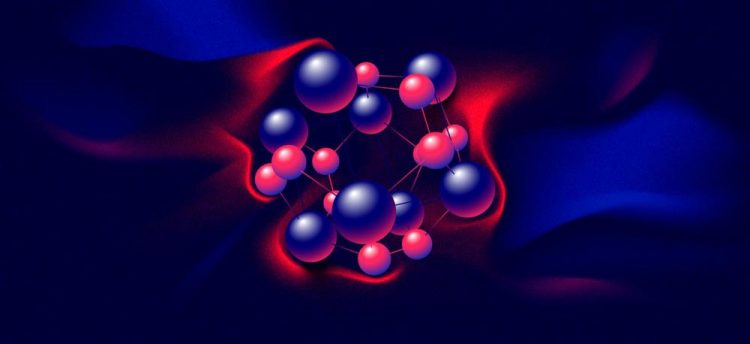Scientists find nanoparticles with peculiar chemical composition

These are nanoparticles. Credit: MIPT Press Office
Micro objects, such as nanoparticles, can differ a lot from macro objects (crystals, glasses) in terms of chemical composition and properties. The two pillars that the nanotechnology rests upon are the wide diversity of properties that nanoparticles of the same material (for example, silicon oxide) but of varying sizes, and the ability to control its properties.
However, both experimental and theoretical research into the structure and composition of nanoparticles encounters major difficulties.
Using the USPEX evolutionary algorithm developed by Artem R. Oganov, professor at Skoltech and MIPT, scientists from China and Russia studied a wide range of nanoparticle compositions and in particular examined two classes of nanoparticles essential for catalysis: iron-oxygen and cerium-oxygen.
They discovered that the so-called “magic nanoparticles” that display enhanced stability can have unexpected chemical compositions, for example, Fe6O4, Fe2O6, Fe4O14, Ce5O6, and Ce3O12. Oxygen-rich nanoparticles, such as Fe4O14, stable at normal conditions, may explain carcinogenicity of oxide nanoparticles. Scientists have quantitatively explored how the compositions vary by changing the temperature or partial pressure of oxygen.
“Stable nanoclusters can possess strange and unexpected chemical compositions (for example, Si4O18 or Ce3O12) at normal conditions, while for crystals this is usually found at extreme conditions, such as high pressures”, – says Xiaohu Yu, the first author of this work, Associate Professor of Shaanxi University of Technology and former member of the Oganov lab in MIPT.
“The fact that nanoparticles have virtually the same ridges, islands of stability and seas of instability as atomic nuclei came as a surprise in this study.
The atomic nucleus and the nanoparticle alike can be described as a cluster of two types of particles, for example, iron and oxygen in our case, or protons and neutrons in the case of atomic nuclei. If you draw a map and plot the numbers of each kind of atoms in the cluster along its axes, you will see that the majority of stable clusters form narrow ridges of stability.
You will also discover islands of stability that are quite curious from the chemical point of view. It is quite conceivable that stable nanoparticles serve as elementary building blocks in crystal growth ? the topic I've been thrilled about since my school years.
As for the islands of stability, the great contributors to their study were our renowned academicians Flerov and Oganesyan that I dreamt of working with when I was a kid,” said Oganov.
Media Contact
All latest news from the category: Life Sciences and Chemistry
Articles and reports from the Life Sciences and chemistry area deal with applied and basic research into modern biology, chemistry and human medicine.
Valuable information can be found on a range of life sciences fields including bacteriology, biochemistry, bionics, bioinformatics, biophysics, biotechnology, genetics, geobotany, human biology, marine biology, microbiology, molecular biology, cellular biology, zoology, bioinorganic chemistry, microchemistry and environmental chemistry.
Newest articles

Bringing bio-inspired robots to life
Nebraska researcher Eric Markvicka gets NSF CAREER Award to pursue manufacture of novel materials for soft robotics and stretchable electronics. Engineers are increasingly eager to develop robots that mimic the…

Bella moths use poison to attract mates
Scientists are closer to finding out how. Pyrrolizidine alkaloids are as bitter and toxic as they are hard to pronounce. They’re produced by several different types of plants and are…

AI tool creates ‘synthetic’ images of cells
…for enhanced microscopy analysis. Observing individual cells through microscopes can reveal a range of important cell biological phenomena that frequently play a role in human diseases, but the process of…





















